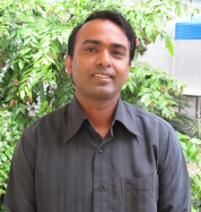Unique hybrid forecasting system could be energy saviour
Published on 02 December, 2010
A Central Queensland-based researcher believes he has the answer for Australia's biggest economic and environmental challenge of the century.
Rahat Hossain, a PhD student at CQUniversity's Power Engineering Research Group within the Institute for Resource Industries and Sustainability (IRIS) has been researching the development of a unique hybrid forecasting system of renewable energy (wind-solar) to be used in conjunction with a 'smart grid'.

PhD student Rahat Hossain has big plans hybrid energy plant.
The system is a first of its type globally and potentially holds the keys to a more sustainable future, with less reliance on coal-fired energy.
Rahat has presented his research during the IRIS Annual Postgraduate Student Conference on Wednesday December 1 at CQUniversity in Rockhampton.
Rahat's research shows Australia in one of the best positions to utilise the hybrid forecasting system which could ideally contribute to an Australian smart grid program.
"Solar and wind energy systems have for some time been considered promising power generators, however a common drawback has been the unpredictable nature and dependence on weather changes," Rahat explained.
"However, by integrating and forecasting the two power sources in a hybrid forecasting system, many of the problems can be overcome."
With the increased complexity of such a system, an accurate forecasting mechanism becomes crucial. Rahat has been working to develop a more robust hybrid forecasting system which can provide accurate renewable energy predictions for the system.
"We have sourced historical solar and wind data from the CSIRO collected over the past 10 years to learn or train the neural network based hybrid forecasting system to predict the energy that could be created by the hybrid wind and solar renewable energy sources.
"The hybrid forecasting model will be developed in such a way that having minor modifications in the coding, it will be able to perform the hybrid forecasting within the interval range from hourly (short term forecasting) to daily (medium term forecasting) within the same platform. This feature is one of the major innovations and indicating the great robustness of the proposed hybrid renewable energy forecasting system."
Rahat believes Australia, and in particular the subtropical regions, are in the best position to utilise this hybrid system. However, it's other countries like Germany that are leading the way in using renewable energy sources.
"Where other countries have already committed and are doing, Australia has just started talking about it."
With Australia already committed to sourcing renewable energy for 20 per cent of its energy by 2020, Rahat believes the Federal Government has to act now.
"If Australia is to meet these targets we have to begin using alternative systems and this hybrid system has real benefits for Australia's climate and landscape.
"Australia has large amounts of land that could be used for wind turbines and also is best located to source solar radiation.
Rahat hopes the Federal Government will back the hybrid system and will support a trial energy station in Central Queensland.
"Wind energy is one of the lowest-priced renewable energy technologies existing today. It is getting cheaper and cheaper to produce wind energy. The cost of generating wind energy has come down by at least 80% since the eighties. Wind energy may shortly be the cheapest way to generate energy on a large scale. With advances in solar panel technology, the cost to produce energy from solar is getting cheaper. As a consequence, the hybrid system has become economically viable."
Rahat came to Australia with his wife back in March with a dream to make a difference to global warming, carbon emissions and the global pollution of the environment.
Previously as an Assistant Professor at the Islamic University of Technology, the Bangladeshi researcher now hopes to continue his work in Australia, contributing to the advancement of information technologies and power system engineering.
"My home country is the biggest sufferer in the world due to CO2 emissions and global warming. It is well established that the ultimate solution to these serious problems is the use of green, clean and environmentally friendly renewable energy sources.
"That is why I started to think how these intermittent renewable energy sources like wind and solar can be used more efficiently, predictably and accurately. Now it is the focus of PhD research."
Rahat is thankful to be conducting his research in Central Queensland in Australia where he can connect with specialists in renewable energies and source relevant research. He was also successful in receiving a Postgraduate Research International Scholarship to complete his PhD at CQUniversity.
Rahat will also be presenting a paper on the evolution of the smart grid at the Australasian Universities Power Engineering Conference in Christchurch, New Zealand, early next month.

